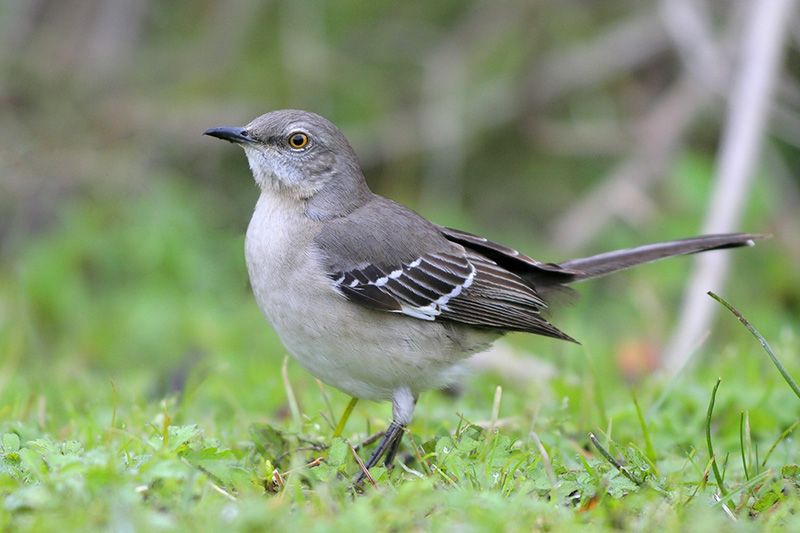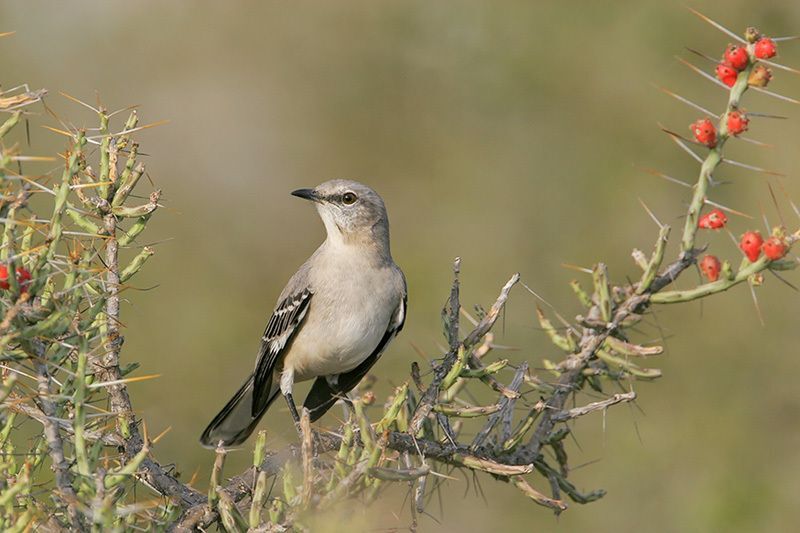Northern Mockingbird

© Wayne Wendel
Mimus polyglottos
Family: (Mimidae) Mockingbirds and Thrashers
Profile by Azure Bevington: Northern Mockingbirds, permanent residents in our area, fill the air with song. These thin long-tailed songbirds, often sing 10-15 different songs in succession and can be heard in a variety of open habitats, including backyards.
Northern Mockingbirds are not shy and often sing from an open high perch, or can be seen running or hopping across the ground chasing insects. They also will aggressively defend their territory from other birds, people, and even squirrels. While they are primarily grayish, with a lighter underside, the flashy white patches on their wings and outer tail feathers can be easily seen in flight. They also often give a wing display, where the open their wings to show off the white patches. One use of this wing raise is to startle invertebrate prey out of their cryptic hiding spots.
Northern Mockingbirds will sing all day and even into the night. Often when you are awoken by a singing mockingbird in the middle of the night it is an unmated male, practicing its expanding repertoire. Night time singing tends to be more common during spring and full moons. They are continually adding new songs. A male mockingbird may learn up to 200 songs throughout its life. The size of a "mockers" repertoire is linked to their breeding success. Both males and females sing, though the females tend to be quieter and rarely sing in the summer. In the past Northern Mockingbirds were often kept in cages and sold as pets in order to have bird songs on demand.
Northern Mockingbirds prefer open areas with a number of perches, such as residential yards, parks, and pastures, where they forage on the ground for insects and small lizards. They also eat a wide variety of berries particularly in the winter and spring and have been seen licking sap from recently pruned trees. Planting a variety of fruiting trees and shrubs, such as mulberries and blackberries, as well as avoiding the use of insecticides, will increase the habitat value and attract mockingbirds to your yard.
Profile: The state bird of Texas, the Northern Mockingbird, is a medium-sized songbird with a slender body and long tail. It is overall grayish brown in color, and has white wing bars that are strikingly visible when in flight. They can be seen in yards, parks, powerlines, forest edges, and open areas.
Mockingbirds are aggressively territorial; they often chase off intruding birds by flying slowly around them and flaunting their white wing patches. They will eat pretty much anything that is available to them, but they prefer insects in the spring and summer and fruits in the fall and winter. They nest in shrubs and small trees and build their nests with twigs, grasses, and sometimes trash.
Mockingbirds are well-known to be impressive mimics. Chances are you have heard this bird cycling through an extensive repertoire of songs. They primarily mimic other birds, but often they will mimic noises you may not expect like a car alarm or a jackhammer. Mockingbirds singing can be recognized by the number of repetitions of the mimicked phrase, usually three or more. This is in contrast to other Mimidae family members, namely the Gray Catbird and Brown Thrasher, with which it may share a soundscape. Their mimicked phrases are uttered once and twice, respectively. Sometimes you will hear a mockingbird calling well into the night especially during a full moon, these are usually unpaired males in desperate search for a mate.
Mockingbirds are fairly widespread in North America and are residents across the state of Texas. They are often easy to spot, perching conspicuously on the tops of trees or telephone wires. Come to our sanctuaries and keep an ear out for these birds; see if you can guess what kinds of sounds they are trying to mimic.
-
Cornell Lab of Ornithology
-
Field Guide
-
Bird Library

© Greg Lavaty, www.texastargetbirds.com

© Greg Lavaty, www.texastargetbirds.com

© Greg Lavaty, www.texastargetbirds.com

© Greg Lavaty, www.texastargetbirds.com

© Greg Lavaty, www.texastargetbirds.com

© Greg Lavaty, www.texastargetbirds.com




















